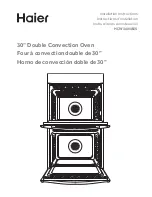
21
BAKING IN THE OVEN
Baking pastry
Most appropriate position for baking is the application of both upper and lower heater, or the hot air.
Warning!
The baking parameters given in Tables are approximate and can be corrected based on your own
experience and cooking preferences;
In case you may not find any particular type of cake in the tables, use the information available for the next
most similar type of cake.
Baking with upper and lower elements
Use only a single guide level.
This baking position is especially suitable for baking dry pastry, bread and teacakes. Use dark baking pans.
Light pans reflect heat and pastry is not adequately browned.
Always place baking pans on the grid rack. Remove the grid only if baking in the flat biscuit tray, supplied
with the appliance.
Preheating shortens the baking time. Do not put the cake in the oven until proper temperature is obtained.
Baking tips
Is cake baked?
Pierce the cake with a wooden skewer at the thickest part, if the dough does not stick to it, the cake is baked.
You may switch off the oven and use the remaining heat.
Cake has fallen
Check the recipe. Use less liquid next time. Follow the mixing times, especially when using electric kitchen
mixers.
Cake is too light on the bottom
Use dark baking pan next time, or place the pan one level lower, or switch on the lower heater a while before
the completion.
Cheese cake is undercooked
Next time reduce the baking temperature and extend the baking time.
Warnings regarding the baking tables
The tables indicate the temperature range. Always select lower temperature first. You may always increase
the temperature in case pastry needs more baking.
Baking times are indicative only.
The asterix indicates that the oven requires preheating.





































